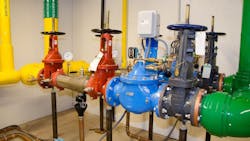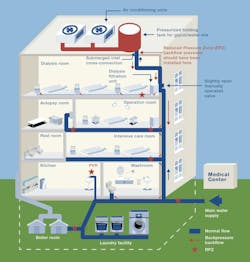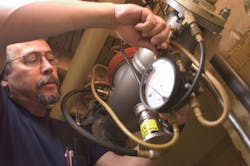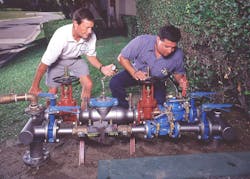Backflow Prevention’s New Role in Water Stewardship and Sustainable Building
Key Highlights
- Backflow prevention is shifting from a safety-only focus to a vital tool for water conservation
- Smart backflow devices with sensors and connectivity enable real-time diagnostics, leak detection, and proactive system management
- Contractors need to stay current with emerging smart water technologies
In an era where sustainability is shaping nearly every facet of construction and infrastructure planning, water systems are no exception. Across the country, contractors, engineers, and facility managers are being asked to deliver more than just code compliance—they’re being challenged to future-proof buildings for climate resilience, resource conservation, and operational efficiency.
While some innovations grab headlines—like rainwater harvesting or greywater reuse—one unsung hero is stepping into the sustainability spotlight: backflow prevention.
Viewed chiefly as a safety mechanism, backflow preventers have long played a critical role in protecting potable water supplies from contamination. Whether in high-rise buildings, schools, industrial plants, or residential complexes, these devices ensure that contaminated or pressurized water doesn't flow backward into the clean water supply—especially in systems that include irrigation, chemical processing, or fire suppression. But today, backflow prevention is becoming part of a larger story, one that links health and safety with environmental stewardship.
Preventing Waste, Protecting Infrastructure
At its core, backflow prevention is about keeping water safe. But increasingly, it’s also about preventing waste.
In the event of a backflow incident, typical remediation protocols involve flushing water systems—a process that can waste thousands of gallons. For buildings in water-stressed regions or under sustainability mandates, that’s not just inefficient—it’s unacceptable.
Water loss from preventable incidents is a hidden but significant contributor to operational inefficiency. Contractors and facility managers are starting to see backflow prevention as a proactive tool in water conservation strategies.
Smart backflow devices now include sensors and connectivity features that provide real-time data on pressure changes, flow rates, and even temperature anomalies—enabling early intervention before a full-scale event occurs. This shift toward intelligent monitoring is helping building teams reduce downtime, avoid water damage, and optimize system performance.
Connected Systems for Smarter Sustainability
The move toward digitization in plumbing and mechanical systems is a broader trend shaping the future of commercial and industrial facilities. Smart backflow preventers can now be integrated into building management systems (BMS), providing facility teams with live diagnostics and alerts. In some cases, these systems go a step further, using analytics to identify usage patterns, leaks, or pressure drops that may indicate larger systemic issues.
One example is the Nexa™ platform, launched in 2024 by Watts. The system offers remote metering, leak detection, and usage analytics across connected devices. It’s designed not only to safeguard systems but to surface opportunities for water reuse or process adjustments—tools that can reduce both consumption and utility costs.
This kind of connectivity is especially impactful in complex buildings such as hospitals, universities, and municipal facilities where water systems must operate at high reliability. It’s not just about avoiding a plumbing failure; t’s about optimizing how we use a finite resource.
Sustainable Operations from Factory to Field
While contractors are increasingly being asked to install systems with strong sustainability credentials, attention is also turning upstream—to how those systems are made. Product sustainability, lifecycle data, and environmental transparency are all under the microscope.
Watts responded by investing in its own operational efficiency. At its Franklin, New Hampshire manufacturing facility, the company reduced water use by 10 percent in 2024—over 650,000 gallons—through real-time monitoring and process changes. Across its global operations, the company has cut water intensity by 62 percent and emissions intensity by 60 percent since 2018.
Importantly, this sustainability isn’t being achieved through short-term fixes. Watts reports that more than one million repair kits were sold in 2024, allowing customers to maintain and extend the life of installed systems rather than replacing them. That’s a nod to circularity—reducing material consumption and embedded emissions while giving contractors tools to meet longevity goals for their clients.
Looking Ahead
What does this mean for the contractor in the field? For one, it highlights the evolving role of mechanical systems in sustainable building design. Products that were once installed for compliance are now being leveraged for performance—not only in protecting health, but in saving resources and supporting larger ESG (environmental, social, governance) goals.
It also underscores the growing expectation that building technologies—even in “hidden” areas like backflow prevention—need to be smart, efficient, and verifiably sustainable.
In 2024, 42 percent of Watts’ global revenue came from clean-tech products, including smart backflow preventers and energy-efficient valves. As demand grows for greener infrastructure and resilient water systems, these solutions are likely to become standard practice—not specialty offerings.
For contractors, that’s both a challenge and an opportunity: a challenge to stay current with emerging technology, and an opportunity to lead projects that perform better, cost less over time, and leave a lighter environmental footprint.
What Contractors Need to Know
While high-level goals like water stewardship and emissions reduction may sound abstract, they’re having a real impact on what gets specified, installed, and maintained in the field. Contractors are increasingly asked to support sustainability outcomes—whether through low-impact product selection, system efficiency, or smart monitoring capabilities.
Backflow prevention is a clear example. Once a simple compliance measure, it’s now a multifaceted tool: protecting potable water, reducing waste, and enabling smarter system management. Devices that offer real-time diagnostics, remote alerts, and lifecycle transparency are becoming more than value-adds—they’re becoming expectations.
Demand for repairability, material conservation, and documented sustainability is growing in both public and private construction. Contractors who understand how to source, install, and service technologies that meet these demands will be better positioned to win projects—especially those with green building requirements or ESG benchmarks.
Ultimately, as smart water infrastructure becomes the new standard, performance and sustainability are converging. For today’s contractor, staying competitive means staying informed—not just about products, but about how they fit into a larger, more resilient water future.
About the Author
Vas Gnanadoss
Vas Gnanadoss is Product Sustainability Engineer at Watts Water Technologies.




